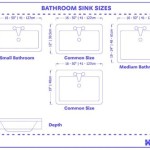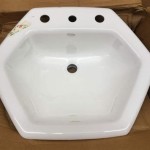What Is The Standard Size Of Bathroom Sink Drain?
Determining the standard size of a bathroom sink drain is essential for various plumbing-related tasks, including sink installation, drain replacement, and identifying compatible plumbing components. This article provides a detailed overview of the standard sizes, components, and considerations related to bathroom sink drains, offering insights into the factors influencing these dimensions and the importance of accurate measurements.
Bathroom sink drains are integral to the functionality of a sink, channeling wastewater away from the basin and preventing leaks or overflows. Understanding the standard sizes and components of these drains is crucial for homeowners, plumbers, and contractors alike. This knowledge facilitates informed decision-making when selecting and installing new sinks or replacing existing drain assemblies.
The information presented here is intended to provide a comprehensive understanding of bathroom sink drain sizes and their significance in plumbing systems. It will cover the typical dimensions, materials, and configurations encountered in residential and commercial settings.
Standard Drain Outlet Size
The most common drain outlet size for bathroom sinks is 1 ¼ inches in diameter. This measurement refers to the inner diameter of the drainpipe that connects directly to the sink basin. The 1 ¼-inch standard is widely adopted across various sink types, including pedestal sinks, vanity sinks, and wall-mounted sinks.
This standardized size ensures compatibility with a wide range of drain assemblies and plumbing fittings. Whether installing a new sink or replacing a drain, the 1 ¼-inch outlet size serves as a universal reference point. However, it is still important to verify the specific requirements of the sink and drain assembly being used to ensure compatibility.
The 1 ¼-inch standard is maintained by most manufacturers of bathroom sinks and drain components. This consistency simplifies the selection and installation process, reducing the likelihood of mismatch and compatibility issues. Deviations from this standard are relatively rare in residential applications, although specialized sinks or custom installations may necessitate non-standard drain sizes.
While the outlet size is typically 1 ¼ inches, the external diameter of the drainpipe might be slightly larger due to the material thickness. This difference is generally negligible when selecting plumbing fittings, as these are designed to accommodate the slight variations.
The standardization of the drain outlet size contributes to the efficiency and cost-effectiveness of plumbing installations. Plumbers can confidently select readily available components knowing they will generally fit the majority of bathroom sinks.
In situations where the existing drain outlet is not the standard 1 ¼ inches, adapters or specialized fittings may be required to ensure a secure and leak-proof connection. These adapters allow for the transition between different pipe sizes and configurations.
Components of a Bathroom Sink Drain Assembly
A typical bathroom sink drain assembly consists of several key components, each playing a specific role in the drainage process. Understanding these components and their respective sizes is crucial for troubleshooting issues and performing repairs.
One of the main components is the drain flange, which sits inside the sink basin and forms the initial point of contact with wastewater. The drain flange typically has a strainer or stopper mechanism to prevent solid objects from entering the drainpipe.
Beneath the sink basin, the drainpipe connects to the tailpiece, a vertical section of pipe that extends downward. The tailpiece is usually made of brass or PVC and is available in various lengths to accommodate different sink configurations.
The P-trap is another essential component, designed to trap debris and prevent sewer gases from entering the bathroom. The P-trap consists of a U-shaped bend in the pipe, which holds a small amount of water to create a seal.
The drainpipe from the P-trap connects to the drainpipe within the wall. This is usually a 1 ½ inch pipe which then ties into the main plumbing system.
Each of these components contributes to the overall functionality of the drain assembly. The sizes of these components must be compatible to ensure a proper fit and prevent leaks.
When replacing any part of the drain assembly, it is essential to select components that match the existing sizes and materials. Using incompatible parts can lead to leaks, reduced drainage efficiency, and potential damage to the plumbing system.
Drain stoppers are also important parts of the sink drain assembly. These come in a few different forms. Lift rod assembly stoppers and push and seal stoppers are the most common kinds of stoppers. Depending on the manufacturer, all models can be slightly different. When you purchase anything to repair the sink drain, be sure that it is the same brand of what is already installed.
Factors Influencing Drain Size
While the 1 ¼-inch drain outlet size is the standard for most bathroom sinks, several factors can influence the choice of drain size in specific situations. These factors include the type of sink, the volume of water expected to be drained, and local plumbing codes.
For example, larger sinks or sinks used in high-traffic areas may benefit from a larger drain size to handle the increased volume of wastewater. In such cases, a 1 ½-inch drain outlet may be preferred to ensure efficient drainage and prevent clogs.
Commercial sinks, such as those found in restaurants or public restrooms, often require larger drain sizes to accommodate the higher volume of water and debris. These sinks may utilize drain outlets of 1 ½ inches or larger, depending on the specific application.
Local plumbing codes can also influence the choice of drain size. These codes are designed to ensure the safety and efficiency of plumbing systems, and they may specify minimum drain sizes for different types of sinks and applications. It is essential to consult local plumbing codes before installing a new sink or replacing a drain to ensure compliance.
The material of the drainpipe can also indirectly influence the overall size and configuration of the drain assembly. For example, PVC pipes may have different outer diameters than brass pipes of the same nominal size. This difference can affect the selection of fittings and connectors.
The design of the sink itself can also influence the choice of drain size. Sinks with unusual shapes or configurations may require specialized drain assemblies with non-standard dimensions. In such cases, it is essential to consult the sink manufacturer's specifications to ensure proper compatibility.
The presence of a garbage disposal unit can also influence the drain size. Sinks with garbage disposals typically require a larger drain outlet to handle the increased volume of solid waste. A 1 ½-inch drain outlet is commonly used in such applications.
The age of the plumbing system can be another factor. Older plumbing systems may have non-standard drain sizes or configurations. When replacing a drain in an older system, it is essential to carefully measure the existing components and select replacement parts that match the original dimensions.
Finally, the aesthetic preferences of the homeowner can also influence the choice of drain size and style. Some homeowners may prefer a specific type of drain strainer or stopper mechanism, which can affect the overall size and appearance of the drain assembly.
By considering these factors, it is possible to select the appropriate drain size and components for any bathroom sink installation, ensuring efficient drainage, preventing leaks, and complying with local plumbing codes.
In summary, while the standard size for a bathroom sink drain outlet is 1 ¼ inches, various factors can influence the choice of drain size in specific situations. These factors include the type of sink, the volume of water expected to be drained, local plumbing codes, and the presence of a garbage disposal unit. By carefully considering these factors, it is possible to select the appropriate drain size and components for any bathroom sink installation. When in doubt, consulting with a qualified plumber is always recommended.

Standard Bathroom Sink Dimensions With Photos Upgradedhome Com

Pop Up Lift Turn Pull Out Stopper Bathroom Sink Drains

Pop Up Lift Turn Pull Out Stopper Bathroom Sink Drains

What Is The Standard Size For Drain Hole In A Bathroom Sink Hunker

Kitchen Sink Drain Size Pantry Storage Ideas Check More At Http Www Entropiads Com Bathroom Countertop Faucets

Bathroom And Restroom Measurements Standards Guide

Homeowner S Guide To Bathroom Sink Dimensions And Sizes The Family Handyman

Standard Bathroom Sink Dimensions With Photos Upgradedhome Com

What Size Pipe For Sink Drain Choosing Tips

Standard Sink Drain Size For Kitchen And Bathroom M2b







